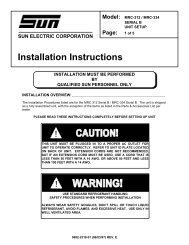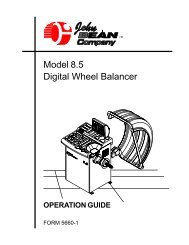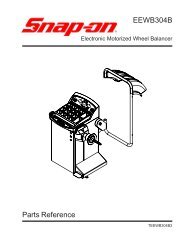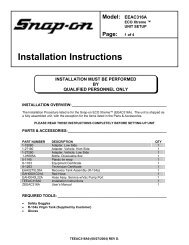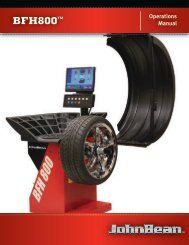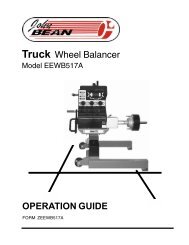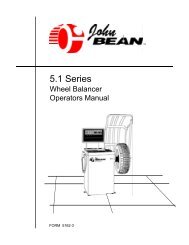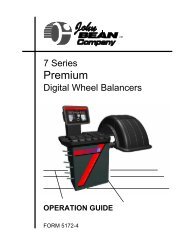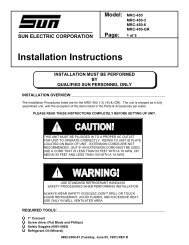chapter 3 checkout-calibration-maintenance procedures - Snap-on ...
chapter 3 checkout-calibration-maintenance procedures - Snap-on ...
chapter 3 checkout-calibration-maintenance procedures - Snap-on ...
You also want an ePaper? Increase the reach of your titles
YUMPU automatically turns print PDFs into web optimized ePapers that Google loves.
CHAPTER 3<br />
CHECKOUT-CALIBRATION-MAINTENANCE PROCEDURES<br />
CHECKOUT PROCEDURES<br />
!<br />
USE STANDARD REFRIGERANT HANDLING<br />
SAFETY PROCEDURES WHEN PERFORMING INSTALLATION<br />
ALWAYS WEAR SAFETY GOGGLES, DON'T SPILL OR TOUCH<br />
LIQUID REFRIGERANT, AVOID FLAMES, AND EXCESSIVE HEAT.<br />
USE ONLY IN WELL VENTILATED AREA.<br />
SYSTEM TEST PROCEDURE:<br />
NOTE: THIS PROCEDURE WILL CHECK OUT THE MAJORITY OF THE UNIT WITHOUT THE<br />
REQUIREMENT FOR HOOK UP TO A VEHICLE.<br />
Shut down unit by turning fr<strong>on</strong>t panel ON/OFF butt<strong>on</strong> OFF.<br />
Turn off Recovery tank valves and remove Vapor hose from RECOVERY tank.<br />
C<strong>on</strong>nect vapor hose to Red vehicle High side hose. High side will display pressure. (MRC-450 uses yellow utility<br />
hose)<br />
With Low side hose c<strong>on</strong>nected open hand valve. (MRC-450, remove Low side vehicle adapter).<br />
Turn unit <strong>on</strong> and program unit to "RECLAIM ONLY".<br />
Low side will display vacuum until it reaches about 4” or 5", where the pump will shut off. If pump turns <strong>on</strong> and off<br />
when appropriate, then transducers are correctly adjusted and unit is operating correctly.<br />
When pump restarts plug low side hose with your thumb to seal system and create a Vacuum.<br />
NOTE: If high side does not increase it will most likely be a restricti<strong>on</strong>, troubleshoot per unit purging.<br />
PUMP CHECKOUT PROCEDURE<br />
TEST COMPLETE<br />
To start and run properly, the vacuum pump requires a properly grounded 115 VAC voltage supply with sufficient<br />
current carrying capacity. If possible, avoid extensi<strong>on</strong> cords. However, if you must use <strong>on</strong>e, it must be at least 18<br />
AWG and not over 10 feet l<strong>on</strong>g.<br />
To c<strong>on</strong>firm operati<strong>on</strong>:<br />
Turn <strong>on</strong> unit and c<strong>on</strong>firm hand valves are closed.<br />
Press Auto sequence.<br />
Enter time for vacuum <strong>on</strong>ly and activate by c<strong>on</strong>tinuing to press the .<br />
Pump will start and displays will show amount of vacuum in "hg".<br />
Cancel operati<strong>on</strong> <strong>on</strong>ce pump is c<strong>on</strong>firmed operating.<br />
If the pump doesn't start, ensure that the above requirements are c<strong>on</strong>firmed; then see Troubleshooting in Chapter<br />
2.<br />
TEST COMPLETE<br />
Effective<br />
2/97 Page 3-1
CHAPTER 3 CHECKOUT-CALIBRATION-MAINTENANCE PROCEDURES (B)<br />
CHECKOUT CHARGE AND RECLAIM PLUMBING<br />
Close both hand valves at the end of the hoses.<br />
Turn <strong>on</strong> the unit and in the Auto sequence, program 4 ounces (0 LB's 4 oz.) of refrigerant. Wait and watch the<br />
displays; the unit should hold the pressure. If not, use leak detector to find leak.<br />
Press , allow unit to operate.<br />
Wait and watch the displays; the unit should decrease the pressure until 4-6 inches is displayed. If it looses<br />
vacuum check reclaim hose fittings.<br />
TRANSDUCER CHECKOUT PROCEDURE<br />
TOOLS REQUIRED: DVM<br />
CHECKOUT COMPLETE<br />
Transducers output a voltage proporti<strong>on</strong>al to amount of pressure they sense. The sucti<strong>on</strong> side transducer outputs<br />
.00025 (.25 millivolts) per psi and the discharge and purge transducers output .0001 ( .1 millivolt) per psi. At<br />
atmosphere, zero pressure, the transducers output voltage is .5 volts D.C. This amplified voltage can be<br />
measured at the cathode of diodes <strong>on</strong> the plumbing board. (Diodes are located in upper right corner of Plumbing<br />
board when installed in unit) To c<strong>on</strong>firm transducers are functi<strong>on</strong>ing properly follow procedure below to measure<br />
.5 volts.<br />
(PROCEDURE BELOW USES EXAMPLE ON LOW PRESSURE TRANSDUCER)<br />
Reclaim any pressure <strong>on</strong> hoses. Open hand valves or disc<strong>on</strong>nect hoses from rear of unit.<br />
C<strong>on</strong>nect DVM red lead to cathode of diode.<br />
(D5 = Purge transducer / D6 = Low transducer D7 = High transducer)<br />
C<strong>on</strong>nect DVM black lead to SP3, (Top Center)<br />
DVM should read .550 volts D.C. plus or minus .05 volts. If not change transducer. (May vary with altitude.)<br />
With 70 psi <strong>on</strong> displays: (D5 = 1.102 volts / D6 = 2.349 volts / D7 = 1.238 volts).<br />
NOTE: DIODE D5 VOLTAGE MAY BE DIFFERENT DUE TO AMOUNT OF AIR IN SYSTEM.<br />
CHECKOUT COMPLETE<br />
SERVICE SUB PAGE, (Raw Scale Weight, Purge Pressure & Temperature).<br />
Press the arrow and the at the same time.<br />
This will display entire scale weight readings live. Press to toggle between Purge pressure and<br />
temperature.<br />
Press to exit.<br />
TANK INSTALLATION (ERROR CODE 9)<br />
Remove all tanks from scale with Power <strong>on</strong> (Including Oil bracket). Turn off unit from rear panel switch.<br />
Wait 10 sec<strong>on</strong>ds and turn <strong>on</strong> rear panel power switch. Turn <strong>on</strong> fr<strong>on</strong>t panel power switch.<br />
Wait for 2 beeps. (Indicating stable scale reading) Carefully install Reclaim tank. Wait for 2 beeps.<br />
Carefully install Virgin tank. Wait for 2 beeps. Carefully install Oil cylinder with bracket. Wait for 2 beeps.<br />
To c<strong>on</strong>firm press for each tank. Correct amount for each tank should be displayed.<br />
CHECKOUT COMPLETE<br />
Effective<br />
Page 3-2 2/97
CHAPTER 3 CHECKOUT-CALIBRATION-MAINTENANCE PROCEDURES (B)<br />
R134a VEHICLE ADAPTERS CHECKOUT PROCEDURE<br />
TOOLS REQUIRED: R134a Service Coupler used to test vehicle adapters P/N 7009-2492-01<br />
1. C<strong>on</strong>nect vehicle adapters to block and open valves.<br />
2. Program 5 minutes of Vacuum and Hold.<br />
3. Do they leak? If so repair leak or replace adapter.<br />
CHECKOUT COMPLETE<br />
SERVICE SUB PAGE, (Raw Scale Weight, Purge Pressure & Temperature).<br />
1. Press the arrow and the at the same time.<br />
2. This will display entire scale weight readings live. Press to toggle between Purge pressure and<br />
temperature.<br />
3. Press to exit.<br />
SOLENOID DIAGNOSTICS (ELECTRIC)<br />
PREREQUISITIES:<br />
The MRC-400/450 has built in diagnostics to test the electrical porti<strong>on</strong> of the unit. Each solenoid is c<strong>on</strong>trolled by<br />
a "SMART DRIVER". These drivers can detect an open or a short. When self diagnostics is performed and a<br />
solenoid is defective the number representing that device will be displayed following the number 4. EXAMPLE:<br />
Err. 405, the 5 represents solenoid S5, the 4 represents an electric problem with the block. Below a list of<br />
solenoid descripti<strong>on</strong>s.<br />
DIAGNOSTIC SOLENOID TEST; TO ACTIVATE W/POWER ON:<br />
NOTE: ON POWER UP, IF ERROR 4XX APPEARS; ACTIVATE TEST W/FRONT PANEL POWER OFF<br />
1. Press and at the same time, "self diag" is displayed and test is in process.<br />
2. Once completed, "ELEC PASS", "PASS PASS" or failure code will be displayed. If solenoid is shorted, <strong>on</strong><br />
power up ERR-4 will be displayed. Perform same test with fr<strong>on</strong>t panel power off to find solenoid.<br />
SOLENOID DESIGNATION / ERROR CODES<br />
SOLENOID VALVES DESCRIPTION ERROR CODES DESCRIPTION<br />
401. C<strong>on</strong>denser S1 ERROR 174 LCD Driver<br />
403. Vent S3 ERROR 140 Upper Led Driver<br />
404. Oil Return S4 ERROR 142 Lower Led Driver<br />
405. Sucti<strong>on</strong> Sep. S5 ERROR146 Plumbing board<br />
406. Vacuum S6 ERROR 148 Plumbing board<br />
407. Crossover S7 ERROR 14A, C, E, 1A2 Plumbing board<br />
408. Oil S8 ERROR 4110 Plumbing board failed, U-10<br />
409. Virgin S9 ERROR 4115 Plumbing board failed, U-15<br />
410. Recovery S10<br />
412. Zero S12<br />
413. Liquid S13<br />
414. Purge S14<br />
CHECKOUT COMPLETE<br />
Effective<br />
12/98 Page 3-3
CHAPTER 3 CHECKOUT-CALIBRATION-MAINTENANCE PROCEDURES (B)<br />
FLOW TEST DIAGNOSTICS (ELECTRIC)<br />
PREREQUISITES: Both tanks must have refrigerant.<br />
Flow test (Displayed: "Flow resr", t looks like r, due to segments <strong>on</strong> displays) was designed to enable testing of<br />
pneumatics. With the hand valves closed a small amount of refrigerant is allowed to escape from both tanks<br />
and reclaimed by the unit.<br />
This slug of refrigerant goes through the Vacuum solenoid into the Sucti<strong>on</strong> Separator bowl, vapor and is<br />
reclaimed by the pump. The vacuum pump sucks the vapor through the system into the c<strong>on</strong>denser where it<br />
returns to a liquid and flows into the Reclaim tank. As this functi<strong>on</strong> flows the transducers m<strong>on</strong>itor the process, if<br />
pressures are not read or are stopped by a restricti<strong>on</strong> the test will fail and an error code exhibited.<br />
FLOW TEST:<br />
1. Open both tanks with refrigerant and close hand valves. (ACT-4500/MRC-450, not c<strong>on</strong>nected to vehicle)<br />
2. Press the while "ELEC PASS" is displayed <strong>on</strong>ce Self Test has completed W/power <strong>on</strong>. (SEE<br />
APPENDIX "F" FOR ERROR CODES) CAUTION: DO NOT PRESS DOWN ARROW THIS WILL ENTER A<br />
MANUFACTURES SUB TEST TO OPEN ALL SOLENOIDS, WITH SOFTWARE 1.10 OR UNDER.FLOW<br />
TEST THEORY OF OPERATION WITH ERROR CODES:<br />
3. Unit looks at Virgin tank switch, if tank is present OK. If not NO VIR 1 is displayed.<br />
4. Unit looks at Oil switch, if oil cylinder is present OK. If not, NO OIL 2 is displayed.<br />
5. Unit looks at Reclaim tank switch to see if tank is present. If not, NO RECLM 3 is displayed.<br />
6. Unit runs reclaim to ensure system is capped off.<br />
7. Sucti<strong>on</strong> Separator switch is m<strong>on</strong>itored with vacuum solenoid opened during Reclaim. Switch should not<br />
close. If it does, 511 is displayed.<br />
8. Unit looks at Reclaim tank switch to see if tank is present. If not, 500 is displayed.<br />
9. Unit looks at Virgin tank switch to see if tank is present. If not, 501 will be displayed.<br />
10. As test procedure c<strong>on</strong>tinues, pump is started and the Vacuum and Sucti<strong>on</strong> Separator solenoids are<br />
powered/opened. Test is timed. If vacuum does not increase to 15" within 7 minutes, then vacuum pump<br />
did not move gas through system and 502 will be displayed.<br />
NOTE: IF RECLAIM EMPTY LIGHT IS ON THIS WILL FAIL DUE INSUFFICIENT REFRIGERANT AMOUNT<br />
11. As pump vacuums system the Low and High transducers react producing low voltages; the unit expects<br />
these changes. If Low pressure transducer does not react 503 is displayed. Or if High pressure transducer<br />
does not react, 504 is displayed.<br />
12. Next voltage is applied to Virgin solenoid S9. The solenoid is opened for a moment allowing the Low<br />
pressure transducer to sense 30 psi or greater. If no pressure is sensed, 505 is displayed.<br />
13. Voltage is applied to Reclaim solenoid S10. The solenoid is opened for a moment allowing the Low pressure<br />
transducer to sense 30 psi or greater. If no pressure is sensed, 506 is displayed.<br />
14. Voltage is applied to Oil solenoid S8. The solenoid is open for a moment allowing the low pressure<br />
transducer to sense an increase. If no pressure is sensed, 507 is displayed.<br />
15. While this pressure is present the Crossover solenoid S7 is closed and more pressure is released. The<br />
pressure <strong>on</strong> the Low and High transducers are compared. The Low pressure transducer should be 30 psi<br />
higher. If not, 508 will be displayed.<br />
16. Now the Crossover solenoid S7 is opened. High pressure transducer is expecting pressure to increase. If no<br />
rise in pressure is attained, 509 will be displayed<br />
17. Vacuum solenoid S6 is opened. Low pressure switch will sense more than 20 psi. If not, unit displays 510.<br />
Effective<br />
Page 3-4 12/98
FLOW TEST DIAGNOSTIC c<strong>on</strong>tinued...<br />
CHAPTER 3 CHECKOUT-CALIBRATION-MAINTENANCE PROCEDURES (B)<br />
18. Sucti<strong>on</strong> Separator solenoid is opened. Low pressure switch should closed and the pressure drops. If not,<br />
512 is displayed.<br />
19. Refrigerant is vacuumed in through the pump and pushed out under pressure. Bypass solenoid is opened<br />
and pressure should decrease. If not, 513 is displayed.<br />
20. C<strong>on</strong>denser solenoid is opened, purge transducer pressure should increase. If not 514 is displayed.<br />
21. As refrigerant c<strong>on</strong>tinues through Liquid solenoid pressure is m<strong>on</strong>itored, if No increase is sensed when Liquid<br />
solenoid was opened, 516 is displayed.<br />
22. System is pressurized, and the Vent solenoid is opened, expecting a drop, no drop and 517 is displayed.<br />
23. While the Purge solenoid is opened, pressure transducer voltage is being m<strong>on</strong>itored for zero pressure, if it<br />
doesn’t corresp<strong>on</strong>d 518 is displayed.<br />
24. When the Zero solenoid is open we expect an increase from the tank, if it doesn’t increase 519 is displayed.<br />
CALIBRATION PROCEDURES<br />
FLOW TEST COMPLETE<br />
SCALE CALIBRATION<br />
TOOLS REQUIRED: 50 LB's OF WEIGHTS IN QUANTITIES OF 10 LB.<br />
NOTE: ONCE IN SERVICE PAGE, TO EXIT, PRESS .<br />
1. Shutoff the valves <strong>on</strong> the tanks and remove everything from of the scale, including the oil bracket.<br />
2. Press up-arrow and power butt<strong>on</strong>s at the same time to access "Raw scale weight". Left display shows<br />
pounds; right display shows ounces.<br />
NOTE: PRESS UP-ARROW TO TOGGLE BETWEEN RAW SCALE WEIGHT & PURGE TRANSDUCER<br />
PRESSURE.<br />
3. Place 10 lb. weight <strong>on</strong> scale, adjust VR1 <strong>on</strong> the Plumbing board (7001-2185-01) for 10.30 lb. <strong>on</strong> left display.<br />
(positive readings could be affected if zero should drift negative, so we added 3 to 12 oz. to compensate,<br />
offset can be as high as 12 oz. c<strong>on</strong>firm linearity by adding 10 pounds before adjusting)<br />
4. Add remaining 40 lb. weight <strong>on</strong> scale, adjust VR2 <strong>on</strong> the Plumbing board for 50.30 LB <strong>on</strong> left display.<br />
Repeat steps 3 and 4 until unit displays correct reading <strong>on</strong> both steps with out any adjusting. Remove<br />
weights.<br />
5. Press to exit.<br />
6. Reinstall tanks, wait for two beeps each time tank is installed.<br />
7. Screw oil bracket and cylinder in place, wait for 2 beeps.<br />
TEMPERATURE PROBE CALIBRATION<br />
CALIBRATION COMPLETE<br />
Calibrati<strong>on</strong> is d<strong>on</strong>e through software, this software adjustment compensates for the added<br />
resistance of the cable compared to the ambient temperature sensor in the unit. This <str<strong>on</strong>g>calibrati<strong>on</strong></str<strong>on</strong>g> is performed<br />
during the unit <str<strong>on</strong>g>calibrati<strong>on</strong></str<strong>on</strong>g>. This also zero's the Low and High transducers.<br />
CALIBRATION COMPLETE<br />
Effective<br />
12/98 Page 3-5
CHAPTER 3 CHECKOUT-CALIBRATION-MAINTENANCE PROCEDURES (B)<br />
TRANSDUCER CALIBRATION<br />
NOTE: UNIT CAN NOT ENTER CALIBRATION IF TRANSDUCERS SENSE PRESSURE. If Transducers<br />
have drifted into PSI, program Vacuum to bring reading down into VACUUM.<br />
1. Turn unit <strong>on</strong>, if displays indicate a pressure press .<br />
2. When completed open the hand valves (Allows transducers to be at atmospheric pressure). On R134a units<br />
remove hoses from rear ports.<br />
3. Press and hold for five sec<strong>on</strong>ds, "CAL" should be <strong>on</strong> both displays.<br />
4. Press , observe that the "IN PROGRESS" LED is flashing and the "HOLD" LED is <strong>on</strong>. To<br />
activate test press the .<br />
NOTE: IF UNIT HAS ANY PRESSURE IN SYSTEM IT WILL RECOVER THE PRESSURE AND THEN ENTER<br />
3 MINUTE DELAY.<br />
1. Temperature will be displayed. Adjust the reading by pressing the or keys untill the display<br />
matches the readings <strong>on</strong> the thermometer. NOTE: The display shows whole numbers <strong>on</strong>ly but the accuracy<br />
of the sensor is .4 degrees. You may have to press or 2 or 3 times to get the temperature<br />
reading to change 1 degree. Select the temperature that most closely matches the thermometer and<br />
press .<br />
2. The "COMPLETED" LED will be <strong>on</strong> and displays will show "O PSI".<br />
3. Remove thermometer, tighten velcro strap around Recovery tank and store vehicle temperature probe.<br />
Close hand valves or rec<strong>on</strong>nect to unit.<br />
CALIBRATION COMPLETE<br />
CUSTOMER CAL OR QUICK CAL (TRANSDUCERS ONLY)<br />
NOTE: UNIT MUST HAVE ATLEAST 2.21 SOFTWARE.<br />
1. Turn <strong>on</strong> unit and wait 3 minutes for stabilizati<strong>on</strong>. If unit displays pressure press .<br />
2. When completed open the hand valves (Allows transducers to be at atmospheric pressure, zero). On R134a<br />
units remove hoses from rear ports.<br />
3. Press and hold for five sec<strong>on</strong>ds or until "CAL" is displayed.<br />
4. In 5 sec<strong>on</strong>ds the displays will indicate 0.<br />
MAINTENANCE PROCEDURES<br />
CALIBRATION COMPLETE<br />
TEMPRITE/OIL RESERVOIR CHECKOUT PROCEDURE<br />
Tools Required: Dip Stick (Make out of coat hanger wire) / OIL PART NUMBER: 0681-0179-02<br />
1. Reclaim any pressure in hoses; <strong>on</strong>ce completed remove the output hose from temprite.<br />
2. Insert dip stick and c<strong>on</strong>firm oil level quantity. (2.5 inches / 13 ounces)<br />
3. Program 5 minutes of vacuum, while pump is running c<strong>on</strong>firm air pressure is escaping from Out port of<br />
Tempright. If not change temprite.<br />
NOTE: IF OIL LEVEL IS EXTREMELY LOW CHECK FOR EXCESS OIL IN PUMP,<br />
CHECKOUT COMPLETE<br />
Effective<br />
Page 3-6 12/98
CHAPTER 3 CHECKOUT-CALIBRATION-MAINTENANCE PROCEDURES (B)<br />
PROCEDURE FOR CHANGING OIL / OIL SHOULD BE CHANGED EVERY 90 DAYS<br />
OIL RESERVOIR MAINTENANCE<br />
This procedure is in reference to the large Temprite oil reservoir. The small reservoir does not require oil<br />
<str<strong>on</strong>g>maintenance</str<strong>on</strong>g> since it does not c<strong>on</strong>tain any oil. The oil level in the reservoir should be checked whenever a<br />
failure such as a leak in the plumbing, excessive purging occurs or compressor is whining.<br />
NOTE: Release pressure in the system by entering the S. S. mode; activate by pressing the red switch<br />
by the sucti<strong>on</strong> separator bowl.<br />
1. Place the Power Switch in the "ON" positi<strong>on</strong>.<br />
2. Close the hand valves at the end of both service hoses.<br />
3. Press .<br />
4. When the green status LED lights, turn POWER OFF. Unplug the MRC from the grounded 110 volt outlet.<br />
5. Remove the two screws under the fr<strong>on</strong>t lip of the c<strong>on</strong>trol panel. Lift up the c<strong>on</strong>trol panel.<br />
!<br />
USE STANDARD REFRIGERANT HANDLING<br />
SAFETY PROCEDURES WHEN PERFORMING INSTALLATION<br />
ALWAYS WEAR SAFETY GOGGLES, DON'T SPILL OR TOUCH<br />
LIQUID REFRIGERANT, AVOID FLAMES, AND EXCESSIVE HEAT.<br />
USE ONLY IN WELL VENTILATED AREA.<br />
6. Remove the three (3) hoses attached to the pump oil reservoir.<br />
7. Remove the nut that secures the oil reservoir to the bottom of the shelf and remove oil reservoir.<br />
8. Invert the reservoir and empty the oil via the "OUTPUT" fitting into an approved c<strong>on</strong>tainer in accordance with<br />
Local, State and Federal regulati<strong>on</strong>s that may apply in your area.<br />
9. Disc<strong>on</strong>nect hoses to compressor. Remove four bolts securing pump to unit.<br />
10. Tip and pour oil out of compressor. Refill with 10 ounces of new oil.<br />
11. Using a small funnel, pour 13 oz. of recommended compressor oil into the outlet port of the reservoir. 13 oz.<br />
of oil will measure 2-1/2" <strong>on</strong> the dip stick.<br />
12. Carefully reinstall the oil reservoir and pump <strong>on</strong>to the shelf in the cabinet. Secure with the hardware<br />
previously removed.<br />
13. Rec<strong>on</strong>nect the yellow hose to the "OIL" port, red hose from compressor to "INLET" port and red hose from<br />
pneumatic block to "OUTLET" port.<br />
14. Lower c<strong>on</strong>trol panel and rec<strong>on</strong>nect the two screws removed in step 5.<br />
CALIBRATION COMPLETE<br />
Effective<br />
12/98 Page 3-7
CHAPTER 3 CHECKOUT-CALIBRATION-MAINTENANCE PROCEDURES (B)<br />
PUMP MAINTENANCE<br />
CHANGING OIL USING A VACUUM SOURCE TO DRAW OUT THE OIL.<br />
OVERVIEW: _____________________________________________________________<br />
Many technicians have inquired about a quicker way of changing the oil in the compressors in our Air<br />
C<strong>on</strong>diti<strong>on</strong>ing Recyclers. Below is a procedure which some of our technicians have already been using and<br />
have c<strong>on</strong>firmed works. We are using as many parts at hand as possible, (Example: Sucti<strong>on</strong> Separator Bowl<br />
and R-12 hose with finger tight fittings #3988-0243-01).<br />
NOTE: First, F.Y.I. we cannot add a oil drain plug because the bottom thickness of the<br />
pump is too thin, we would have to weld an additi<strong>on</strong>al piece of metal to the<br />
bottom and then make the drain. This added cost is not feasible.<br />
PARTS LIST: ____________________________________________________________<br />
• Hoses: 2 Hoses with finger tight fittings. (8’ hose 3988-0243-01 to be c<strong>on</strong>nected to vacuum source),<br />
(18” yellow hose 3988-0246-01 to be used w/catheter tube)<br />
• Vacuum Pump: Any vacuum pump is acceptable.<br />
• Opti<strong>on</strong>al: Tiny firm tube, which would fit into the fitting <strong>on</strong> the pump. (Example: Catheter tube, 14 inches)<br />
Insert catheter tube into hose with finger tight fitting prior to the start.<br />
Removing oil using an opti<strong>on</strong>al catheter tube.<br />
1. If there is any refrigerant or oil in the Sucti<strong>on</strong> Separator bowl, perform bowl <str<strong>on</strong>g>maintenance</str<strong>on</strong>g>, bowl must be<br />
empty. Remove desiccant bag and discard for this procedure.<br />
2. Turn off the unit and unplug the cord from the wall outlet.<br />
3. Remove the two bolts under the fr<strong>on</strong>t lip of the tester and open the top.<br />
4. Disc<strong>on</strong>nect the two hoses/tubes from the Sucti<strong>on</strong> Separator bowl.<br />
5. Attach <strong>on</strong>e end of a 8’ hose to the left side (inlet) of the sucti<strong>on</strong> separator bowl. The other end to the<br />
vacuum source. See figure 1 <strong>on</strong> the next page.<br />
6. C<strong>on</strong>nect the hose with catheter tube to the right side (outlet) of the Sucti<strong>on</strong> Separator bowl.<br />
Remove top hose from compressor.<br />
7. Turn <strong>on</strong> vacuum source, and insert the catheter tube inside the compressor. As so<strong>on</strong> as it reaches the oil,<br />
the tube will fill, causing the oil to be collected in the sucti<strong>on</strong> separator bowl.<br />
NOTE: M<strong>on</strong>itor Sucti<strong>on</strong> Separator bowl so it doesn’t over flow. Pumps make a lot of noise when they<br />
are over filled.<br />
8. If oil stops, c<strong>on</strong>tinue to push the catheter tube down into compressor, perform this step a few times until<br />
compressor is empty. This may take some practice and patience.<br />
9. Shutoff the vacuum source, and remove the catheter tube.<br />
10. Remove the bowl and discard the oil properly.<br />
11. Remove the hoses c<strong>on</strong>nected in steps 4 & 5 and c<strong>on</strong>nect to original positi<strong>on</strong>.<br />
12. C<strong>on</strong>tinue to filling compressor with oil.<br />
PROCEDURE COMPLETE<br />
Effective<br />
Page 3-8 12/98
CHAPTER 3 CHECKOUT-CALIBRATION-MAINTENANCE PROCEDURES (B)<br />
INSIDE UNIT<br />
Catheter<br />
Tube<br />
OIL<br />
COMPRESSOR<br />
VACUUM<br />
SOURCE<br />
Figure - 1<br />
Removing oil without catheter tube:<br />
1. If there is any refrigerant or oil in the Sucti<strong>on</strong> Separator bowl, perform <str<strong>on</strong>g>maintenance</str<strong>on</strong>g>, bowl must be empty.<br />
Remove desiccant bag for this procedure.<br />
2. Turn off the unit and unplug the cord from the wall outlet.<br />
3. Remove the two bolts under the fr<strong>on</strong>t lip of the tester and open the top.<br />
4. Disc<strong>on</strong>nect the two hoses/tubes from the Sucti<strong>on</strong> Separator bowl.<br />
5. Access the compressor. Remove top hose from compressor.<br />
6. Attach hose to top fitting <strong>on</strong> pump. This will require hose with finger type fitting. Attach other end to right<br />
side of sucti<strong>on</strong> separator bowl. The bowl catches the oil.<br />
7. Unbolt the pump and turn upside down, the other hose may have to be removed. This will bring the oil to the<br />
fitting.<br />
8. Attach <strong>on</strong>e end of a 8’ hose to the left side the sucti<strong>on</strong> separator bowl.<br />
9. C<strong>on</strong>nect the other end to vacuum source.<br />
10. Turn <strong>on</strong> vacuum source, and a vacuum will be applied thru the hoses and bowl to the pump, causing the oil<br />
to be collected in the sucti<strong>on</strong> separator bowl.<br />
11. After a few moments all the oil will be in the bowl. Shutoff the vacuum source.<br />
12. Return compressor to upright positi<strong>on</strong> and rec<strong>on</strong>nect hoses to there original state.<br />
13. Remove the bowl and discard the oil properly.<br />
PROCEDURE COMPLETE<br />
Filling oil<br />
1. Use the hose that c<strong>on</strong>nects to the vacuum port <strong>on</strong> the compressor, disc<strong>on</strong>nect it from the block.<br />
2. Pour 10 ounces of compressor oil (3GS/ 300 ves.) into c<strong>on</strong>tainer and insert the hose into the oil.<br />
3. Plug in cord into outlet and turn <strong>on</strong> unit.<br />
4. Program unit for 5 minutes of vacuum. As pump is energized the oil will be drawn into the pump in sec<strong>on</strong>ds.<br />
5. When finished press “Cancel” to stop the pump. Reassemble pump and hoses.<br />
OIL FILL COMPLETE<br />
Effective<br />
12/98 Page 3-9
CHAPTER 3 CHECKOUT-CALIBRATION-MAINTENANCE PROCEDURES (B)<br />
PROCEDURE TO DISASSEMBLE BLOCK ASSEMBLY<br />
CAUTION:<br />
ALWAYS WEAR GOGGLES AND RELEASE PRESSURE BEFORE REMOVING ANY<br />
COMPONENTS. TO RELIEVE PRESSURE IN SUCTION SEPARATOR BOWL, ENTER S. S.<br />
MODE BY PRESSING THE SWITCH BY THE S. S. BOWL.<br />
SOLENOID DESCRIPTION PART NUMBER QTY. DESCRIPTION PART NUMBER QTY.<br />
Normally Closed 0304-0905-01 9 O-Ring (Small, S7) 0617-0211-01 1<br />
Normally Open through (S7) 0304-0905-02 1 O-Ring (Med.) 0617-0211-02 9<br />
Normally Open (Liquid, S11) 0304-0905-03 1 O-Ring (Large) 0617-0211-03 -<br />
Normally Closed through (S14) 0304-0905-04 1 O-Ring (Extra Large) 0617-0211-04 14<br />
In order to service <strong>on</strong>e of the sandwiched solenoids you will have to disassemble the block.<br />
NOTE: S7 solenoid c<strong>on</strong>nects both blocks. There will be an o-ring between the top of S7 and the fr<strong>on</strong>t block.<br />
Fr<strong>on</strong>t block will detach.<br />
Remove four countersunk screws, carefully move block assembly forward so it can be supported.<br />
Disassemble solenoid found defective in self diagnostics. Simply remove the top nut and housing/coil assembly.<br />
Then remove the shaft assembly with a flat blade screw driver from the brass solenoid body.<br />
Remove the plunger guide from shaft assembly.<br />
Clean solenoid body and replace O-ring; check plunger guide.<br />
Once all parts have been cleaned, lubricated, or changed reassemble solenoid.<br />
Reinstall solenoid back in block.<br />
Reassemble block making sure O-ring from S7 is in place (a little oil might help).<br />
PROCEDURE COMPLETE<br />
Effective<br />
Page 3-10 12/98



